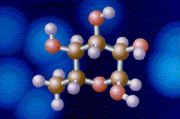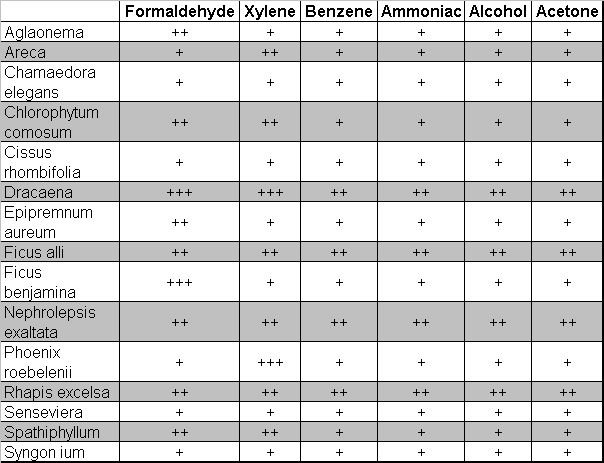


 |
Index page |
|
|
TASK 4ABSORPTION OF INDOOR POLLUTANTS BY PLANTSInternational researches
Several researches have shown that indoor plants can improve indoor air quality. I am going to present two of them.
The NASA Studies
The NASA studies of indoor plants for air quality improvement were conducted in 1989. The NASA researchers (Dr. B.C. Wolverton, Anne Johnson and Keith Bounds)spent two years testing nineteen different common houseplants for their ability to remove harmful elements. The harmful elements tested were : thrichloroethylene, benzene and formaldehyde. Of the nineteen plants they studied, fifteen were considered to be capable of reducing the studied VOC's. This is the list of these fifteen indoor plants :
- Philodendron scandens “oxycardium”, heartleaf philodendron
- Philodendron domesticum, elephant ear philodendron
- Dracaena fragrans “Massangeana”, cornstalk dracaena
- Hedera helix, English ivy
- Chlorophytum comosum, spider plant
- Dracaena deremensis “Janet Craig”, Janet Craig dracaena
- Ficus benjamina, weeping fig - Spathiphyllum “Mauna Loa”, peace Lily
- Philodendron selloum, selloum philodendron
- Aglaonema modestum, Chinese evergreen
- Chamaedorea sefritzii, bamboo or reed palm
- Sansevieria trifasciata, snake plant
- Dracaena marginata, red-edged dracaena
This following graph is the comparison of the fifteen different houseplants' ability to remove pollutants :
As you can see, dracaena plants are one of the more efficient houseplants to remove pollutants. Ficus alli, nephrolepsis exaltata and rhapis excelsa plants have also good effects on the indoor air pollutants.
Research at the University of Technology in Sydney ("Plant/soil capacities to remove harmful substances from polluted indoor air") The researchers (R.A. Wood, M.D. Burchett RA Orwell, J.Tarran and F.Torpy) compared the VOc removal performance of 3 top-selling indoor plants species : the Kentia Palm, the Peace Lily and the Janet Craig dracaena. The VOCs tested were the benzene and the n-hexane because they are common in indoor air. Results of the research: ! Overall all three species were found to be effective removers of both VOCs. ! Immediatly after applying the first dose of VOC the removal rates were very slow. However, within a fairly short time (1-2 days for benzene; 4-5 days for n-hexane), they accelerated markedly. This increase in rate was in response to a "taste" of the VOC. It involves the induction of a biochemical system to deal with the compound (consume and metabolise it). ! The system gets better on exposure to VOCS and maintains performance with repeated doses. ! From 3 to 10 times the maximum permitted Australian occupational indoor air concentrations of each compound can be removed within about 24 hours, under light or dark conditions without saturating the system. ! When they removed the plants, replaced the potting mix into the pots and put the pots back into the chambers, the VOC again continued to disappear. Thus, the researchers said : "First, the continued activity confirms that it is a true biological response, and not merely an adsorption/absorption process. Secondly, it shows that it must be the micro-organisms of the potiing mix that are the "rapid-removal agents" of the pot-plant system. The plants is somehow involved, however." ! When the plant was transferred to hydroponics (the roots were thorougly washed in sterile water to remove particles of the potting mix and if possible some of the micro-organisms clinging to the surface of the roots), some VOC removal continued to occur. They concluded that "this suggestst that the micor-organisms are at least in some cases fairly firmly attached onto or inside the roots" and "the differences in response among the plant species in this medium sugeest different relationships between the plant and the micro-organisms associated with the root system. ! When unplanted potting mix is dosed with VOC, tests showed a very slow induction and removal activity. The researchers said that "the results confirm what is known of potting mixes generally, namely that they contain a supply of micro-organisms before plants are introduced". However, "the results also suggest that the readily available nutrients for microbial growth and reproduction in the potting mix will not last very long in the absence of a growing plant".
So this study permits us to better understand the process of pollutants removal by the plants. The plants absorb the pollutants by their leaves but the real removal agent then are the micro-organisms present in the soil.
You can send comments : aub@niras.dk
Started by NIRAS supervisor Sergio Fox on 27th March 2006. © COPYRIGHT 2001 ALL RIGHTS RESERVED Aurelie.dk |

